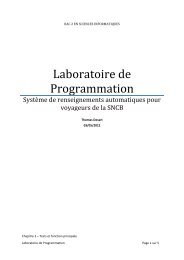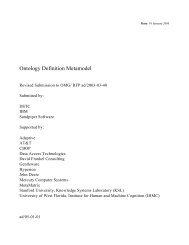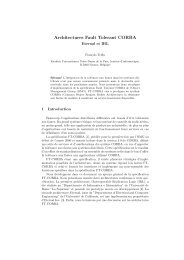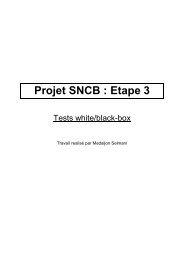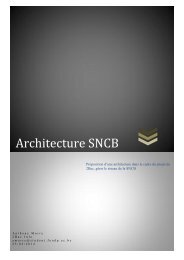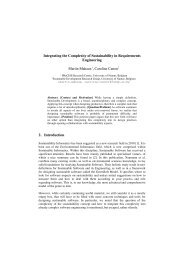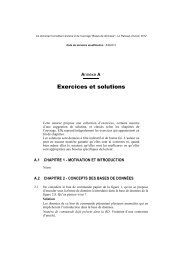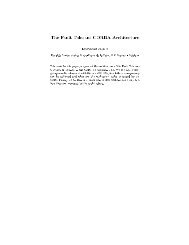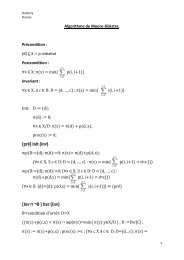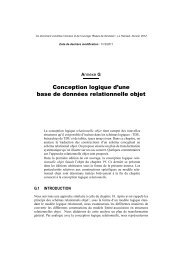Database Reverse Engineering - A Case Study - Institut d'Informatique
Database Reverse Engineering - A Case Study - Institut d'Informatique
Database Reverse Engineering - A Case Study - Institut d'Informatique
You also want an ePaper? Increase the reach of your titles
YUMPU automatically turns print PDFs into web optimized ePapers that Google loves.
- 1,000 files, 50 of which being relevant;<br />
- these 50 files include 100 record types and 3,000 fields;<br />
- more than one DMS (for instance COBOL files + a CODASYL database);<br />
- more sophisticated constructs such as : alternate field structures, overlapping foreign keys, transitive and<br />
embedded foreign keys, conditional identifier and foreign keys, field redundencies, explicit NEXT<br />
pointers [Premerlani,93] [Blaha,95];<br />
- conflicting structures and views<br />
- usage of data dictionaries, CASE tools, generators.<br />
It is important to notice that we have translated the data structures only. We have to mention two additional<br />
problems : converting the COBOL data into relational data, and converting the COBOL programs into<br />
COBOL/SQL programs. But this is another, more complex, story.<br />
At the present time, practically no commercial CASE tool can cope with even such a simple application.<br />
Obviously, much work must be devoted to the fundamentals of <strong>Database</strong> reverse engineering, and to CASE<br />
tools that can be used not only by their developers, but also by analysts and programmers. The DB-MAIN<br />
project aims, among others, at developing methodologies and CASE tools to help solve these problems. Its<br />
reverse engineering functions have been used in several industrial projects in redocumentation, conversion and<br />
migration projects. An Education version is available for non-profit organizations.<br />
8. References<br />
Andersson, M. 1994. Extracting an Entity Relationship Schema from a Relational <strong>Database</strong> through <strong>Reverse</strong><br />
<strong>Engineering</strong>, in Proc. of the 13th Int. Conf. on ER Approach, Manchester, Springer-Verlag<br />
Blaha, M.R., Premerlani, W., J. 1995. Observed Idiosyncracies of Relational <strong>Database</strong> designs, in Proc. of the 2nd<br />
IEEE Working Conf. on <strong>Reverse</strong> <strong>Engineering</strong>, Toronto, July 1995, IEEE Computer Society Press<br />
Bolois, G., Robillard, P. 1994. Transformations in Reengineering Techniques, in Proc. of the 4th Reengineering<br />
Forum "Reengineering in Practice", Victoria, Canada<br />
Casanova, M., Amarel de Sa, J. 1983. Designing Entity Relationship Schemas for Conventional Information Systems,<br />
in Proc. of ERA, pp. 265-278<br />
Casanova, M., A., Amaral De Sa. 1984. Mapping uninterpreted Schemes into Entity-Relationship diagrams : two<br />
applications to conceptual schema design, in IBM J. Res. & Develop., Vol. 28, No 1<br />
Chiang, R., H., Barron, T., M., Storey, V., C. 1994. <strong>Reverse</strong> <strong>Engineering</strong> of Relational <strong>Database</strong>s : Extraction of an<br />
EER model from a relational database, Journ. of Data and Knowledge <strong>Engineering</strong>, Vol. 12, No. 2 (March<br />
94), pp107-142<br />
Davis, K., H., Arora, A., K. 1985. A Methodology for Translating a Conventional File System into an Entity-<br />
Relationship Model, in Proc. of ERA, IEEE/North-Holland<br />
Davis, K., H., Arora, A., K. 1988. Converting a Relational <strong>Database</strong> model to an Entity Relationship Model, in Proc.<br />
of ERA : a Bridge to the User, North-Holland<br />
Edwards, H., M., Munro, M. 1995. Deriving a Logical Model for a System Using Recast Method, in Proc. of the 2nd<br />
IEEE WC on <strong>Reverse</strong> <strong>Engineering</strong>, Toronto, IEEE Computer Society Press<br />
Fong, J., Ho, M. 1994. Knowledge-based Approach for Abstracting Hierarchical and Network Schema Semantics, in<br />
Proc. of the 12th Int. Conf. on ER Approach, Arlington-Dallas, Springer-Verlag<br />
Fonkam, M., M., Gray, W., A. 1992. An approach to Eliciting the Semantics of Relational <strong>Database</strong>s, in Proc. of 4th<br />
Int. Conf. on Advance Information Systems <strong>Engineering</strong> - CAiSE'92, pp. 463-480, May, LNCS, Springer-<br />
Verlag<br />
Hainaut, J-L., Cadelli, M., Decuyper, B., Marchand, O. 1992. <strong>Database</strong> CASE Tool Architecture : Principles for<br />
Flexible Design Strategies, in Proc. of the 4th Int. Conf. on Advanced Information System <strong>Engineering</strong><br />
(CAiSE-92), Manchester, May 1992, Springer-Verlag, LNCS<br />
Hainaut, J-L., Chandelon M., Tonneau C., Joris M. 1993a. Contribution to a Theory of <strong>Database</strong> <strong>Reverse</strong><br />
<strong>Engineering</strong>, in Proc. of the IEEE Working Conf. on <strong>Reverse</strong> <strong>Engineering</strong>, Baltimore, May 1993, IEEE<br />
Computer Society Press<br />
Hainaut, J-L, Chandelon M., Tonneau C., Joris M. 1993b. Transformational techniques for database reverse<br />
engineering, in Proc. of the 12th Int. Conf. on ER Approach, Arlington-Dallas, E/R <strong>Institut</strong>e and Springer-<br />
Verlag, LNCS<br />
FIIA96 (04/04/07) 12



